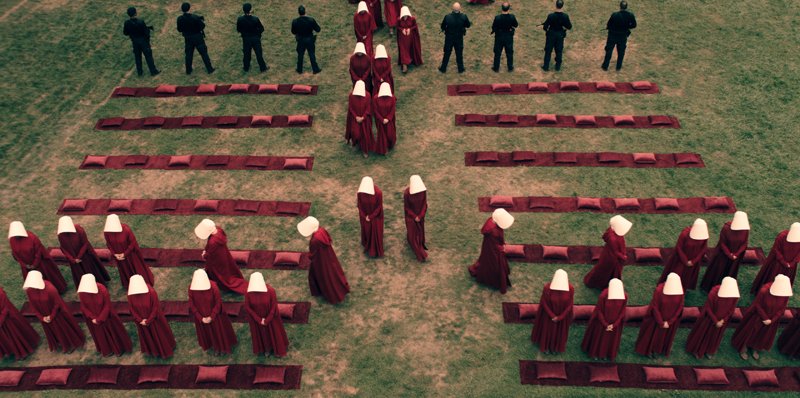Everyone’s heard that story about a frog sitting in a kettle of water, where the heat is gradually increased. Initially, the frog’s insides acclimatise to the rising temperature and in doing so dies before realising it’s too late. Something similar is narrated in Hulu’s The Handmaid’s Tale, when the protagonist says that they were all asleep as the country slowly acceded to a totalitarian government. Even as martial law is passed to ‘protect the country against terrorists’, Bank accounts of women are frozen and the millitary starts escorting them out of their workplace, we’re shown how the world didn’t meet its dystopian version overnight. It was gradual.

The five-part miniseries at its very basic, is a commentary on women’s rights. It is a haunting and vivid portrait of gender inequality, even in our modern world. I wouldn’t be surprised to learn about an unhinged MRA (Men’s Rights Activist) frothing at his mouth, declaring the show ‘feminist propaganda’ in some corner of the world . Even though the adaptation comes nearly three decades after Margaret Atwood’s source material hit the bookstands, there doesn’t seem to have been a time more ripe for it. In a time when buzzwords ‘misogyny’ and ‘chauvinism’ are becoming frighteningly casual, we need The Handmaid’s Tale to draw us a picture of what happens when it becomes normalised and ‘the law’.
The show begins with a family of three trying to escape the law enforcement of a newly-formed state. Even as the man is shot down, the mother and the daughter make a run into a cold forest. Sure enough, they would be found and the 7-year-old daughter would be separated from her mother. The woman in question, is now transferred to the ‘Red Centre’ where she would be ‘trained’ along with a bunch of other women to fulfill their privilege – bear children for the barren families of commanders. This is no longer ‘the land of the free, home of the brave’, as we’re told the state capital has been moved to Anchorage and only two stars remain on the national flag (each star represents a state on the American flag). Names have been erased and our protagonist is given the name Offred. (Of-Fred, based on the name of her commander).
It is only fitting that in a story about oppressed women, we see only two male characters reduced to serviceable plot points. On the other hand the women unravel their true selves in all shades of the good, the ballsy, the free-spirited, the bad and the ugly. They’re also designated with code of colours. Wives of the commanders wear green, the Marthas (cooks and cleaners) wear grey, while the Handmaid wear red cloaks.
There are at least a couple of instances when the show paints us a picture of the desperation. We’re told about the spike in the rate of infant deaths where ‘only one in five survives’. And as the protagonist’s baby breathes as the lucky one, a deranged mother kills a nurse to stake her claim to the newborn. There are also women who are discovered to be ‘gender traitors’ (read: lesbians) and we’re shown their last ride in the back of a van. Both of them gagged and their hands tied, they exchange a million apologies, promise to meet in the afterlife through their eyes. The scene ends horrifically with only one of them surviving.
These are only a couple of instances in a narrative which seems to be bursting with kinetic energy. Elizabeth Moss (June/Offred) is picture perfect in (dare I say) every scene of the show, even with her involuntary shrugs. Samira Wiley (Moira, who plays June’s best friend), Madeline Brewer (Janine), Yvonne Strahkovski (Mrs Waterford) and Joseph Fiennes (Commander Waterford) all play with unpredictable intensity. Not a single character in the show is a stereotype, they’re all human beings enduring an unnatural time. Some with hope and allegiance, while some with fear and paranoia. As one of the character philosophises at one point, “Every love story is a tragedy, if you wait long enough.”
The Handmaid’s Tale incorporates many parallels from contemporary first world countries including fake news propaganda, Big Brother figures like ‘The Eye’ hinting at the Government’s mass surveillance, the casual sexism where the leader of a country commodifies women by ‘grabbing them by the p*****s’ and still gets elected. A time when religion, race and gender overrule reason. And that is the most frightening part of the show, its relevance.
The show is frighteningly ‘current and topical’ not only because it points out what is wrong with the world today, but because it also gives us a clear picture of what it could become. Lest we stop adjusting to kettle’s rising temperature and get the hell out.